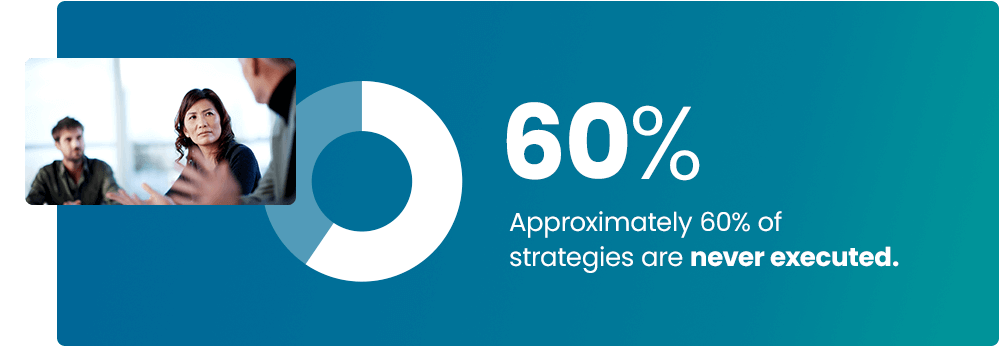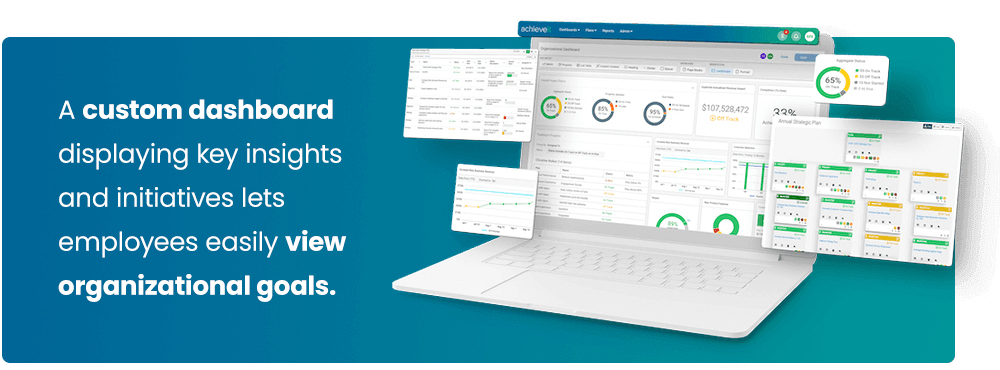Strategic plan execution is essential for boosting productivity and reaching goals. When we plan to execute strategies, we must consider how well we can follow through and improve outcomes. Understanding how to make tough decisions is only the beginning of a well-executed plan. You must also have effective tools and communication to reach your company’s initiatives.
In This Article
- Why Is the Execution of the Strategy So Important?
- How to Foster a Strategy Execution Culture
- Create a Culture of Strategic Execution With AchieveIt’s Software Solutions
Why Is the Execution of the Strategy So Important?
Strategic plan execution is important because it’s what drives results. Creating a strategy is only a small part of increasing productivity and reaching goals. While making hard decisions and planning action steps are necessary, what follows is what truly matters.
A lack of strategy execution hinders goals and pushes deadlines back. Strategic execution is one of the main problems CEOs face, and approximately 60% of strategies are never executed. Improving strategic planning and execution can be simple and effective when you create a culture of strategy execution in your workplace and take advantage of the right software.

How to Foster a Strategy Execution Culture
Leading the drive for good strategy execution and operating excellence calls upon managers to lead their teams effectively. You can create a strategic execution culture with the following tips:
1. Hardwire Accountability
Being productive is different from being busy, and efficiency should be your primary focus when reaching goals. An efficient worker who prioritizes quality over quantity in their work is valuable because they reach goals quickly and effectively. Holding employees accountable for their actions helps them prioritize the most critical tasks.
You can do this by choosing the right metrics and helping employees understand why certain items are important. When you complete performance reviews at the end of the year, you should focus your evaluations on how well each employee’s actions moved your metrics forward rather than considering how many tasks they completed.
Transparency
Hardwiring accountability starts with making your strategic plans more transparent. If you communicate your overall goal and how each employee’s tasks are designed to help achieve that goal, it’s easier for employees to do the following:
- Feel motivated
- Understand the value of their jobs
- Track their actions toward that goal
Closed-door meetings may be necessary to evaluate strategic plans and make difficult decisions, but you should communicate with supervisors and employees afterward. Employees should clearly understand the goals, metrics and concepts you decide upon in your meetings so they can work toward goals effectively.
The more they understand why they have certain projects on their schedule and how their assignments move metrics forward, the more they can prioritize tasks and deliver quality results. Not only are things getting accomplished, but reports are clearer and more streamlined.

Communication
Transparency requires effective communication. You don’t need to tell employees about every single thing you and the rest of your C-Suite decide, but you should communicate your big objectives in the following ways:
- Align your strategies with your mission and vision.
- Communicate strategies and objectives in orientations and training.
- If you have status meetings, talk about any new strategic efforts there.
- Make sure employees are clear on why they are doing the tasks they are doing.
- Show the metrics you are tracking and let employees have insights into how the company is doing when it comes to meeting those measurable objectives.
BONUS DOWNLOAD: 3 Strategies that Elevate Organizational Accountability
2. Involve Employees in the Change Process
Employees can work smarter and more efficiently when they have the proper support. Involving them in the culture change process and decision-making allows them to voice their ideas and tell you what would help them reach the company’s goals. For example, employees may identify unimportant tasks that consume most of their time or reporting processes the company could adjust. Employees familiar with specific tasks may provide ideas for completing work faster or develop a simpler way to report metrics and results.
It’s also helpful to align strategies in ways that relate to employee motivations and passions. While many employees are motivated toward organizational change, most are not truly bought in until they understand what’s in it for them. According to the “What’s in it for me?” (WIIFM) principle, employees are inherently motivated to achieve goals when they have a personal stake involved. While they may not openly admit it, your team wants to understand what role they play in the organization’s key initiatives and make an impactful difference.
3. Reduce Change Fatigue Due to Competing Priorities
In most organizations, strategy is an afterthought amongst the whirlwind of day-to-day responsibilities. This may sound unbelievable to the strategists reading, but this is true of many organizations.
With the numerous reports, meetings, trainings, assignments and deadlines employees are responsible for, individuals begin to decide what is important and unimportant. Employees typically deem the items they hear about frequently, such as operational efficiency and revenue, as important. Similarly, they usually consider the items they hear about infrequently, such as long-term objectives, as less important.

Employees receive an overwhelming amount of information, leading to competing priorities, change fatigue and apathy toward strategy. Making strategy a key priority helps increase its importance in employees’ minds, so increased visibility is essential. For example, a custom dashboard displaying key insights and initiatives lets employees easily view organizational goals. With this tool, employees can align to-do lists under important organizational objectives and gain a better perspective on which tasks are the most impactful.
4. Support Cultural Change With Proper Systems, Processes and Incentives
Cultural change and execution require dedication and commitment to move the needle. Strong processes and systems make goals easier to reach. If you are serious about creating cultural change and executing strategies, make a commitment with a refined process and system. Once you have the process, you can work on increasing acceptance and participation across the organization, particularly at the leadership level. Having a process with high participation and enforcement often results in successful execution.
Strategic planning software makes it easier to communicate clearly with all employees and leadership levels. Innovative software provides consistent tracking so you can monitor each strategic execution plan and measure how well your team is meeting goals.
Create a Culture of Strategic Execution With AchieveIt’s Software Solutions
A strategic execution plan is successful when all leaders and employees are invested in a company’s goals and have the resources to follow through effectively. AchieveIt offers strategic planning software to help your company build plans, track progress, assess performance and produce positive outcomes.
We understand how important each strategy execution plan is, so we make it easy for you to communicate objectives across your teams. Request a demo to experience how AchieveIt can help you connect and execute your key initiatives.



